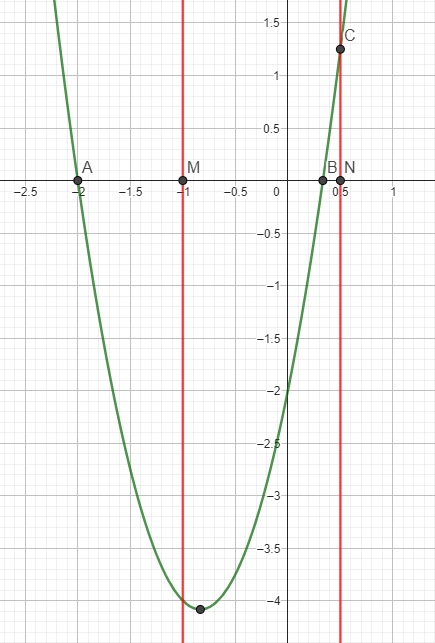Tìm đạo hàm của hàm số :
\(y=\dfrac{2}{\cos\left(\dfrac{\pi}{6}-5x\right)}\)
Chứng minh rằng các hàm số sau có đạo hàm không phụ thuộc vào x :
a) \(y=\sin^6x+\cos^6x+3\sin^2x.\cos^2x\)
b) \(y=\cos^2\left(\dfrac{\pi}{3}-x\right)+\cos^2\left(\dfrac{\pi}{3}+x\right)+\cos^2\left(\dfrac{2\pi}{3x}-x\right)+\cos^2\left(\dfrac{2\pi}{3x}+x\right)-2\sin^2x\)
a) Cách 1: Ta có:
y' = 6sin5x.cosx - 6cos5x.sinx + 6sinx.cos3x - 6sin3x.cosx = 6sin3x.cosx(sin2x - 1) + 6sinx.cos3x(1 - cos2x) = - 6sin3x.cos3x + 6sin3x.cos3x = 0.
Vậy y' = 0 với mọi x, tức là y' không phụ thuộc vào x.
Cách 2:
y = sin6x + cos6x + 3sin2x.cos2x(sin2x + cos2x) = sin6x + 3sin4x.cos2x + 3sin2x.cos4x + cos6x = (sin2x + cos2x)3 = 1
Do đó, y' = 0.
b) Cách 1:
Áp dụng công thức tính đạo hàm của hàm số hợp
(cos2u)' = 2cosu(-sinu).u' = -u'.sin2u
Ta được
y' =[sin - sin
] + [sin
- sin
] - 2sin2x = 2cos
.sin(-2x) + 2cos
.sin(-2x) - 2sin2x = sin2x + sin2x - 2sin2x = 0,
vì cos = cos
=
.
Vậy y' = 0 với mọi x, do đó y' không phụ thuộc vào x.
Cách 2: vì côsin của hai cung bù nhau thì đối nhau cho nên
cos2 = cos2
'
cos2 = cos2
.
Do đó
y = 2 cos2 + 2cos2
- 2sin2x = 1 +cos
+ 1 +cos
- (1 - cos2x) = 1 +cos
+ cos
+ cos2x = 1 + 2cos
.cos(-2x) + cos2x = 1 + 2
cos2x + cos2x = 1.
Do đó y' = 0.
Tìm đạo hàm các hàm số:
1, \(y=\tan(3x-\dfrac{\pi}{4})+\cot(2x-\dfrac{\pi}{3})+\cos(x+\dfrac{\pi}{6})\)
2, \(y=\dfrac{\sqrt{\sin x+2}}{2x+1}\)
3, \(y=\cos(3x+\dfrac{\pi}{3})-\sin(2x+\dfrac{\pi}{6})+\cot(x+\dfrac{\pi}{4})\)
a.
\(y'=\dfrac{3}{cos^2\left(3x-\dfrac{\pi}{4}\right)}-\dfrac{2}{sin^2\left(2x-\dfrac{\pi}{3}\right)}-sin\left(x+\dfrac{\pi}{6}\right)\)
b.
\(y'=\dfrac{\dfrac{\left(2x+1\right)cosx}{2\sqrt{sinx+2}}-2\sqrt{sinx+2}}{\left(2x+1\right)^2}=\dfrac{\left(2x+1\right)cosx-4\left(sinx+2\right)}{\left(2x+1\right)^2}\)
c.
\(y'=-3sin\left(3x+\dfrac{\pi}{3}\right)-2cos\left(2x+\dfrac{\pi}{6}\right)-\dfrac{1}{sin^2\left(x+\dfrac{\pi}{4}\right)}\)
tính đạo hàm của các hàm số sau
a, y=\(-\dfrac{3x^4}{8}+\dfrac{2x^3}{5}-\dfrac{x^2}{2}+5x-2021\)
b, y= \(\sqrt{x^2+4x+5}\)
c, y=\(\sqrt[3]{3x-2}\)
d, y=(2x-1)\(\sqrt{x+2}\)
e, y=\(sin^3\left(\dfrac{\pi}{3}-5x\right)\)
g, y=\(cot^{^4}\left(\dfrac{\pi}{6}-3x\right)\)
a.
\(y'=-\dfrac{3}{2}x^3+\dfrac{6}{5}x^2-x+5\)
b.
\(y'=\dfrac{\left(x^2+4x+5\right)'}{2\sqrt{x^2+4x+5}}=\dfrac{2x+4}{2\sqrt{x^2+4x+5}}=\dfrac{x+2}{\sqrt{x^2+4x+5}}\)
c.
\(y=\left(3x-2\right)^{\dfrac{1}{3}}\Rightarrow y'=\dfrac{1}{3}\left(3x-2\right)^{-\dfrac{2}{3}}=\dfrac{1}{3\sqrt[3]{\left(3x-2\right)^2}}\)
d.
\(y'=2\sqrt{x+2}+\dfrac{2x-1}{2\sqrt{x+2}}=\dfrac{6x+7}{2\sqrt{x+2}}\)
e.
\(y'=3sin^2\left(\dfrac{\pi}{3}-5x\right).\left[sin\left(\dfrac{\pi}{3}-5x\right)\right]'=-15sin^2\left(\dfrac{\pi}{3}-5x\right).cos\left(\dfrac{\pi}{3}-5x\right)\)
g.
\(y'=4cot^3\left(\dfrac{\pi}{6}-3x\right)\left[cot\left(\dfrac{\pi}{3}-3x\right)\right]'=12cot^3\left(\dfrac{\pi}{6}-3x\right).\dfrac{1}{sin^2\left(\dfrac{\pi}{3}-3x\right)}\)
Tịnh tiến đồ thị hàm số y= cos x sang phải \(\dfrac{\pi}{2}\) ta được đồ thị hàm số nào
A. \(y=sinx\)
B.\(y=-cosx\)
C.\(y=\)\(cos\left(x+\dfrac{\pi}{2}\right)\)
D.\(y=sin\left(x-\dfrac{\pi}{2}\right)\)
Tìm giá trị max, min của các hàm số sau:
1, y= 2 - \(\sin\left(\dfrac{3\pi}{2}+x\right)\cos\left(\dfrac{\pi}{2}+x\right)\)
2, y= \(\sqrt{5-2\sin^2x.\cos^2x}\)
1, \(y=2-sin\left(\dfrac{3x}{2}+x\right).cos\left(x+\dfrac{\pi}{2}\right)\)
\(y=2-\left(-cosx\right).\left(-sinx\right)\)
y = 2 - sinx.cosx
y = \(2-\dfrac{1}{2}sin2x\)
Max = 2 + \(\dfrac{1}{2}\) = 2,5
Min = \(2-\dfrac{1}{2}\) = 1,5
2, y = \(\sqrt{5-\dfrac{1}{2}sin^22x}\)
Min = \(\sqrt{5-\dfrac{1}{2}}=\dfrac{3\sqrt{2}}{2}\)
Max = \(\sqrt{5}\)
Tìm đạo hàm của hàm số :
\(f\left(t\right)=\dfrac{\cos t}{1-\sin t}\) tại \(t=\dfrac{\pi}{6}\)
tìm tập xác định của hàm số lượng giác sau
a)\(y=\dfrac{tan\left(2x-\dfrac{\pi}{4}\right)}{\sqrt{1-sin\left(x-\dfrac{\pi}{8}\right)}}\)
b)\(y=\dfrac{tan\left(x-\dfrac{\pi}{4}\right)}{1-cos\left(x+\dfrac{\pi}{3}\right)}\)
c)\(y=\dfrac{3}{cosx-cos3x}\)
d)\(y=\dfrac{4}{sin^2x-cos^2x}\)
e)\(y=\dfrac{1+cot\left(\dfrac{\pi}{3}+x\right)}{tan^2\left(3x-\dfrac{\pi}{4}\right)}\)
Tìm số giá trị của m để hàm số \(y=\sqrt{4\left(sin^6x+cos^6x\right)-6m.sin2x+2-m^2}\) xác định trên \(\left(\dfrac{-5\pi}{12};\dfrac{\pi}{12}\right)\)
Ủa sao xài hoành độ đỉnh ở đây được nhỉ, phải xài nghiệm (đúng hơn là lợi dụng quy tắc dấu tam thức bậc 2 "trong khác - ngoài cùng")
Đây, ví dụ 1 trường hợp cho em (bài này ở trên đã đưa dấu a>0 theo thói quen). 2 đường màu đỏ là khoảng \(\left(-1;\dfrac{1}{2}\right)\), rõ ràng đỉnh parabol nằm trong khoảng đó nhưng trên khoảng \(\left(-1;\dfrac{1}{2}\right)\) hàm vẫn có 1 đoạn nhận giá trị dương (tương ứng với đoạn BC)

Cách làm đúng ở đây là cần sử dụng quy tắc tam thức bậc 2 (hoặc 1 số pp khác nhưng ko thể là hoành độ đỉnh). Lợi dụng quy tắc tam thức bậc 2: nếu pt bậc 2 có 2 nghiệm \(x_1;x_2\) thì \(a.f\left(x\right)< 0\) với \(x\in\left(x_1;x_2\right)\) và \(a.f\left(x\right)>0\) với \(x\notin\left(x_1;x_2\right)\).
Do đó để \(f\left(x\right)< 0\) ; \(\forall x\in\left(p;q\right)\) nào đó (khi a dương), đồng nghĩa khi đó p và q phải nằm giữa 2 nghiệm, hay \(f\left(p\right)\) và \(f\left(q\right)\) đều âm.
Hàm xác định trên khoảng đã cho khi và chỉ khi:
\(4\left(sin^6x+cos^6x\right)-6m.sin2x+2-m^2\ge0;\forall x\in\left(...\right)\)
\(\Leftrightarrow4\left[\left(sin^2x+cos^2x\right)^3-3sin^2x.cos^2x\left(sin^2x+cos^2x\right)\right]-6m.sin2x+2-m^2\ge0;\forall x\in...\)
\(\Leftrightarrow-3sin^22x-6m.sin2x-m^2+6\ge0\)
Đặt \(sin2x=t\Rightarrow t\in[-1;\dfrac{1}{2})\)
\(\Rightarrow f\left(t\right)=3t^2+6mt+m^2-6\le0\)
Theo định lý về dấu của tam thức bậc 2 thì điều này xảy ra khi và chỉ khi:
\(\left\{{}\begin{matrix}f\left(-1\right)\le0\\f\left(\dfrac{1}{2}\right)< 0\end{matrix}\right.\) \(\Leftrightarrow\left\{{}\begin{matrix}m^2-6m-3\le0\\m^2+3m-\dfrac{21}{4}< 0\end{matrix}\right.\)
Ủa biến đổi có sai ở đâu ko mà BPT cuối nhìn nghiệm xấu vậy
Tìm txđ của hàm số sau:
1.\(y=\sqrt{\dfrac{1+cosx}{1-cosx}}\)
2.\(y=\dfrac{3}{sin^2x-cos^2x}\)
3.\(y=cos\left(x-\dfrac{\pi}{3}\right)+tan2x\)
1. Hàm số xác định `<=> 1-cosx \ne 0<=>cosx \ne 1<=>x \ne k2π`
Vì: `1+cosx >=0 forallx ; 1-cosx >=0 forall x`
2. Hàm số xác định `<=> sin^2x \ne cos^2x <=> (1-cos2x)/2 \ne (1+cos2x)/2`
`<=>cos2x \ne 0<=> 2x \ne π/2+kπ <=> x \ne π/4+kπ/2`
3. Hàm số xác định `<=> cos2x \ne 0<=> x \ne π/4+kπ/2 (k \in ZZ)`.